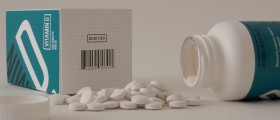
Vitamin A - General Info
Vitamin A together with vitamins D, E and K belongs to a group of liposoluble vitamins. These vitamins can get accumulate inside human body if taken in excessive doses and can cause serious damage to many structures. This is why the toxic and all the other side effects of taking too much of these vitamins must be noticed on time and treated properly.
Vitamin A is very important substance. It is essential for many processes in the body including cell growth, division and differentiation. Furthermore, vitamin A is powerful promoter of the mucous layer of the skin and other tissues. And finally, retinol is essential for normal transfer of light signals to the nerves of the retina. Vitamin A is normally found in fruits, vegetables and animal food products. It can be taken in two different forms, as retinol and beta-carotene.
Recommended daily doses for vitamin A are 5000 IU. Prolonged intake of doses higher than the previously mentioned eventually leads to vitamin A toxicity. Vitamin toxicity may be acute (caused by intake of high doses of vitamin A) or chronic (intake of slightly increased doses for longer period of time). Retinol is the active form of the vitamin A and it can be found in foods such as liver, eggs, cheese and seafood while beta-carotene represents a precursor of vitamin A. Beta-carotene is a component of many fruit and vegetables such as carrot, sweet potato, tomato, orange etc.
Vitamin A Deficiency and Vitamin A Toxicity
Neither lack of vitamin A nor its excessive intake is considered good for the body. Vitamin A deficiency typically features with eye problems, weakened immune system and skin changes. Lack of vitamin A in children causes growth retardation. Prolonged deficiency of this vitamin leads to night blindness and if left untreated a person may completely lose vision. Vitamin A deficiency is treated with suitable amount of food rich in this vitamin and with vitamin A supplements.
Vitamin A toxicity is caused by excessive intake of vitamin A and body's capability to store this vitamin. Vitamin A toxicity may be acute or chronic.
The symptoms and signs of vitamin A toxicity basically depend on the severity of the condition. For example, excessive intake of provitamin a called beta-carotene usually features with yellowish-orange discoloration of the palms and soles. Apart from the previously mentioned there are no additional serious symptoms or signs of the condition. A treatment is simple and includes reduction in intake of food rich in carotene.
On the other hand, acute toxicity with a vitamin A leads to bone tenderness and muscle pain. The pain generally affects the muscles in the hands and feet. There is also chance of mild neurological disorder.
Chronic vitamin A toxicity causes brittle nails, conjunctivitis, abnormal reddening of the skin, edema, peripheral neuritis and loss of hair. In extreme cases the toxicity can cause liver cirrhosis.

















Your thoughts on this
Loading...